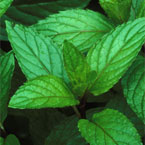Peppermint Oil

On this page:
Introduction
This fact sheet provides basic information about peppermint oil—common names, what the science says, potential side effects and cautions, and resources for more information.
The herb peppermint, a cross between two types of mint (water mint and spearmint), grows throughout Europe and North America. Peppermint is often used to flavor foods, and the leaves can be used fresh or dried in teas. Today, peppermint oil is used as a folk or traditional remedy for nausea, indigestion, cold symptoms, headaches, muscle and nerve pain, stomach problems, and bowel conditions such as irritable bowel syndrome.
Essential oil of peppermint may be found in very small doses in capsule or liquid forms. The essential oil can also be diluted with another oil and applied to the skin.
What the Science Says
- Results from several studies suggest that peppermint oil may improve symptoms of irritable bowel syndrome.
- A few studies have found that peppermint oil, in combination with caraway oil, may help relieve indigestion, but this evidence is preliminary.
- Although there are some promising results, there is no clear-cut evidence to support the use of peppermint oil for other health conditions.
Side Effects and Cautions
- Peppermint oil appears to be safe for most adults when used in small doses. Possible side effects include allergic reactions and heartburn.
- Capsules containing peppermint oil are often coated to reduce the likelihood of heartburn. If they are taken at the same time as medicines such as antacids, this coating can break down more quickly, thus increasing the risk of heartburn.
- Tell all your health care providers about any complementary health practices you use. Give them a full picture of what you do to manage your health. This will help ensure coordinated and safe care. For tips about talking with your health care providers about complementary and alternative medicine, see NCCAM’s Time to Talk campaign.
Sources
- Peppermint. In: Blumenthal M, Goldberg A, Brinckman J, eds. Herbal Medicine: Expanded Commission E Monographs. Newton, MA: Lippincott Williams & Wilkins; 2000:297–303.
- Peppermint. Natural Medicines Comprehensive Database Web site. Accessed at www.naturaldatabase.com on July 22, 2009.
- Peppermint oil (Mentha x piperita L.). Natural Standard Database Web site. Accessed at www.naturalstandard.com on July 22, 2009.
For More Information
NCCAM Clearinghouse
The NCCAM Clearinghouse provides information on NCCAM and complementary health approaches, including publications and searches of Federal databases of scientific and medical literature. The Clearinghouse does not provide medical advice, treatment recommendations, or referrals to practitioners.
PubMed®
A service of the National Library of Medicine (NLM), PubMed® contains publication information and (in most cases) brief summaries of articles from scientific and medical journals.
Office of Dietary Supplements (ODS), National Institutes of Health (NIH)
ODS seeks to strengthen knowledge and understanding of dietary supplements by evaluating scientific information, supporting research, sharing research results, and educating the public. Its resources include publications (such as Dietary Supplements: What You Need to Know), fact sheets on a variety of specific supplement ingredients and products (such as vitamin D and multivitamin/mineral supplements), and the PubMed® Dietary Supplement Subset.
NIH National Library of Medicine's MedlinePlus
This publication is not copyrighted and is in the public domain. Duplication is encouraged.
* Note: PDF files require a viewer such as the free Adobe Reader.
